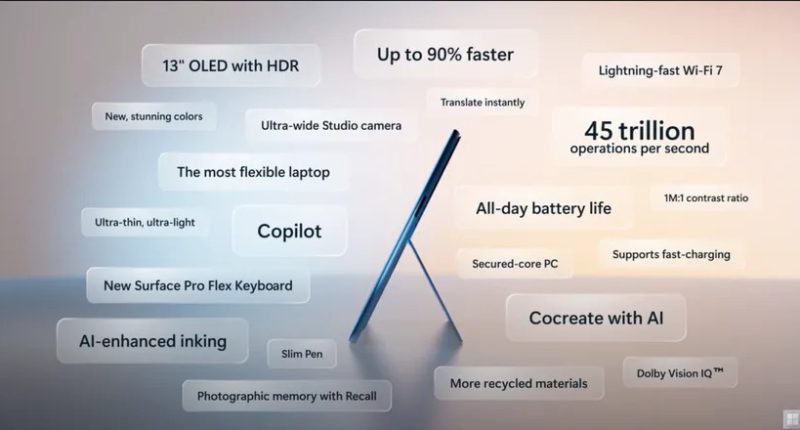Microsoft has officially launched the 11th iteration of its Surface Pro series, marking a significant milestone in its line of hybrid tablet-laptop devices. This new model brings advanced AI capabilities and performance upgrades.
Christened the Surface Pro 11th Edition and positioned as the inaugural member of the “Copilot Plus PC” family, the device boasts a comprehensive overhaul, encompassing significant performance upgrades, advanced AI capabilities, and a host of design refinements. Notably, Microsoft has decided to drop numerical model designations, signaling a fresh start for the lineup. From the looks of it, the tech titan intends this to be a complete reboot, offering a significant leap forward from previous generations.
At the core of the new Surface Pro is a substantial performance enhancement. This comes courtesy of the all-new Qualcomm Snapdragon X processor family, available in both Elite and Plus variants. Microsoft claims this translates to a remarkable 90% performance improvement over its predecessor, a significant leap that positions the Surface Pro as a more compelling option for demanding users. There is also the (eventual) inclusion of an optional 5G modem.
For those who are worried that this will burn a hole in their pockets, the Surface Pro 11th Edition starts at a competitive $1,000 for the base model, equipped with a Snapdragon X Plus chip, a standard LCD screen, 256GB of storage, and 16GB of RAM. This price point positions the Surface Pro as an option for users seeking a powerful and versatile 2-in-1 device without breaking the bank. Upgrading to the coveted OLED display necessitates a jump to the Snapdragon X Elite chip and bumps the starting price to $1,500. These are available for pre-order now, and models equipped with built-in 5G connectivity are expected to be available later this year.
One of the most significant upgrades in the new Surface Pro is the integration of advanced AI capabilities. The device features a Neural Processing Unit (NPU) dedicated to handling on-device AI tasks. During the launch event, Microsoft CEO Satya Nadella emphasized the importance of AI in the new Surface Pro, describing it as the embodiment of the “next phase of Windows and computing.” This focus on AI is reflected in features like “Recall,” a functionality that tracks user activities and allows retrieval of past moments using natural language commands. This will make revisiting a specific slide within a past presentation or recalling a snippet of text you were working on days ago far easier. The device also boasts a dedicated Neural Processing Unit (NPU) specifically designed to handle on-device AI tasks efficiently, ensuring a smooth and responsive user experience without compromising battery life. The new Surface Pro offers up to 14 hours of local video playback.
For users seeking a more immersive visual experience, the Surface Pro 11th Edition offers an optional OLED display. This display technology boasts superior contrast ratios and deeper blacks compared to traditional LCD screens, resulting in richer, more vibrant colors and enhanced image clarity. However, indulging in this visual feast comes at a premium, as OLED displays are only available in configurations with the higher-tier Snapdragon X Elite processor and increased storage capacity. The Surface Pro 11th Edition also retains the familiar tablet-with-kickstand design that has become synonymous with the lineup. However, Microsoft has incorporated several refinements that elevate the user experience. The device now sports a sleek 13-inch OLED display (or a standard LCD display in base models) with slimmer bezels, maximizing screen real estate and fostering a more immersive visual experience. Two USB-C ports provide enhanced connectivity options, while a significant upgrade comes in the form of the “quad-HD” front-facing camera, ideal for high-resolution video conferencing.
Accompanying the Surface Pro 11th Edition is the new Surface Pro Flex keyboard attachment. Designed for both attached and detached use, it boasts increased durability compared to previous iterations, addressing a common pain point for users who found earlier keyboards prone to wear and tear. The keyboard incorporates bold keys for improved user experience and a 14% larger touchpad, promoting accessibility for a wider range of users. Additionally, the Flex Keyboard features haptic feedback. The Flex Keyboard is priced at $350, or $450 when bundled with a Surface Pen, making it a premium addition to the Surface Pro ecosystem.
The Tech Portal is published by Blue Box Media Private Limited. Our investors have no influence over our reporting. Read our full Ownership and Funding Disclosure →






